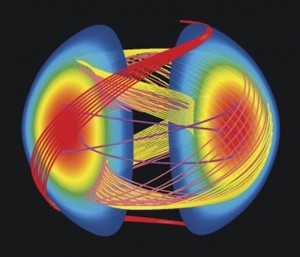
3D graphene to replace platinum in dye-sensitized solar apps?
Dye-sensitized solar cells are thin, flexible, easy to make, and efficient. However, they use platinum, and, at $1,500 an ounce, the cost of the precious metal is significant even in the small quantities used in dye-sensitized cells. Now researchers at Michigan Technological University, Houghton, have developed an inexpensive material that could replace the platinum in solar cells without degrading their efficiency: 3D graphene. The team synthesized a unique 3D version of the material with a honeycomb-like structure by combining lithium oxide with carbon monoxide in a chemical reaction that forms lithium carbonate and the honeycomb graphene. The Li2CO3 helps shape the graphene sheets, isolates them from one other to prevent graphite formation, and can be easily removed, the scientists say. They replaced the platinum counterelectrode in a dye-sensitized solar cell with one made of the 3D honeycomb graphene, then compared its output to a platinum-containing cell. Results were nearly identical: The cell with the 3D graphene counterelectrode showed efficiency of 7.8 percent, compared with 8 percent for the platinum-containing cell.
Silica Möbius strips tie liquid crystals in knots
University of Warwick scientists have shown how to tie knots in liquid crystals using a miniature Möbius strip made from silica particles, paving the way for development of the next generation of advanced materials and photonic devices, the university says. Liquid crystals are composed of long, thin, rod-like molecules that align themselves so they all point in the same direction. The scientists literally tied them in knots by adding a micron-sized silica particle to disrupt the material’s molecular orientation, creating crystals with three, four, or five knots depending on the number of twists in the silica colloid. The researchers believe the resulting intricate knotted fields provide a possible path to the design of new metamaterials and photonic devices.
Technique allows real-time observation of radiation-induced voids in Mg
A team led by North Carolina State University researchers has developed a technique that provides real-time images of how magnesium changes at the atomic scale when exposed to radiation. The approach may give researchers new insights into how radiation impacts the integrity of radiation-tolerant materials, such as those used in space exploration and in nuclear energy technologies. Scientists used high-resolution transmission electron microscopy to simultaneously irradiate the magnesium and collect images of the material at the atomic scale, observing formation and expansion of voids in the material. The researchers investigated magnesium because of its hexagonal structure, which it shares with many radiation-tolerant materials, and because it takes less energy to cause void formation in magnesium than in other materials with similar structures, such as zirconium.
Recycled concrete filters bind phosphorus in rainwater runoff
(Eurekalert) Large amounts of phosphorus-containing fertilizer runoff can be washed into lakes and streams when it rains, resulting in increased algae growth, oxygen depletion, and a reduction in the number of species that can live in the water. But filters made of crushed concrete can remove up to 90 percent of the P from runoff, according to researchers at University of Southern Denmark. The scientists say the portland cement in concrete contains calcium, aluminum, and iron, all three of which can bind phosphorus. Preliminary results show that smaller concrete grains bind phosphorus better than larger particles, and that the pH of discharge water from the concrete filters must be adjusted in the first months of operation to make it less alkaline. The scientists believe the filters can last a long time, probably several years, before new filtration elements would be needed.
Glass goblet showcases Roman nanotechnology
(Smithsonianmag.com) The colorful secret of a 1,600-year-old Roman glass chalice at the British Museum may pave the way to new technology to diagnose disease or pinpoint biohazards at security checkpoints, researchers say. The Lycurgus Cup appears jade green when lit from the front but blood-red when lit from behind—a phenomenon caused when Roman artisans impregnated the glass with gold and silver nanoparticles as small as 50 nm in diameter, according to University of London researchers who analyzed shards from the cup. Now scientists at University of Illinois at Urbana-Champaign trying to use the same effect for medical diagnostic applications have shown that a material analogous to that used in the cup can display a range of colors depending on the type of liquid in contact with the material. The technology may one day make its way into handheld devices for detecting pathogens in samples of saliva or urine, or for thwarting terrorists trying to carry dangerous liquids onto airplanes, the scientists say.

